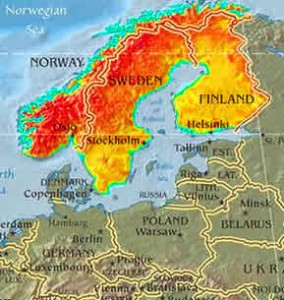
Although they are also called Scandinavian languages, due to geographic and linguistic distances between these islands and the Scandinavian region itself, one could say that it is more sensible to reserve the term “Scandinavian” to refer to the languages spoken in Denmark, Norway and Sweden.
Some time ago, we wrote an article in Spanish that explains a bit the origin of these languages and what they resemble. Here we explained that the Danish, Swedish and Norwegian languages are intelligible languages, because speakers can understand each other without the need for formal training or studying the other language.
The three languages are very similar, even more so in their writing. You can assume that a speaker of one of them can read the other two. It is in the spoken version where the deeper differences are perceptible. For example, in most cases, Norwegians and Swedes have more difficulty in properly pronouncing Danish than either of the other two. This is not true in the opposite case, i.e., a Dane could better understand the other two. Norwegian is closer to Danish, in regard to grammar, but is much closer to Swedish in terms of phonetics.
Norwegian proper came to life after the country’s separation from Sweden, since until then they had spoken a “Norwegianized” version of Danish. Norway, by then separated from Sweden, recognized both languages as official languages of the country in the late nineteenth century.
After an unsuccessful attempt to unify both languages in the mid-twentieth century, the two regional variants acquired the same status, coexisting in public administration, schools, churches, media and books.
Danish is a language of simple grammar but complex phonetics. The number of vowels is impressive, and, in most cases, they are completely arbitrary, so in most cases only overseas experience can help distinguish the correct sounds corresponding to written text.
In the case of Sweden, the distances and differences between the northern and southern dialects are translated into distinct features. For example, the region of Skaane, due to its proximity to Denmark, has a lot of “Danish touches”. Swedish phonetics is simpler than Danish. For pronunciation, it is even more marked. However, the grammar is as simple as Danish or Norwegian, which makes it a somewhat more accessible language to learn than the other two.
Then, as we explained in our article, it is very interesting to learn beyond the purely linguistic aspects. As always, we encourage you to cross cultural barriers and learn to translate subtleties when translating. It is important to understand and identify where the translated material is going in order to localize it according to the characteristics of the audience that will receive it.
You can send any questions or concerns to “Translation Services“.
(Versión en español: https://www.trustedtranslations.com/lenguas-nordicas-cuanto-se-asemejan-2011-04-27.html)





